List of Contents
Rheology Modifiers Market Size and Forecast 2025 to 2034
The global rheology modifiers market size accounted for USD 8.93 billion in 2024 and is expected to exceed around USD 13.55 billion by 2034, growing at a CAGR of 4.25% from 2025 to 2034. Rheology modifiers market is expanding due to increasing demand for the product from paints and coatings and personal care and cosmetics along with an increased in shale gas exploration and production of crude oil is expected to further growth of the market.
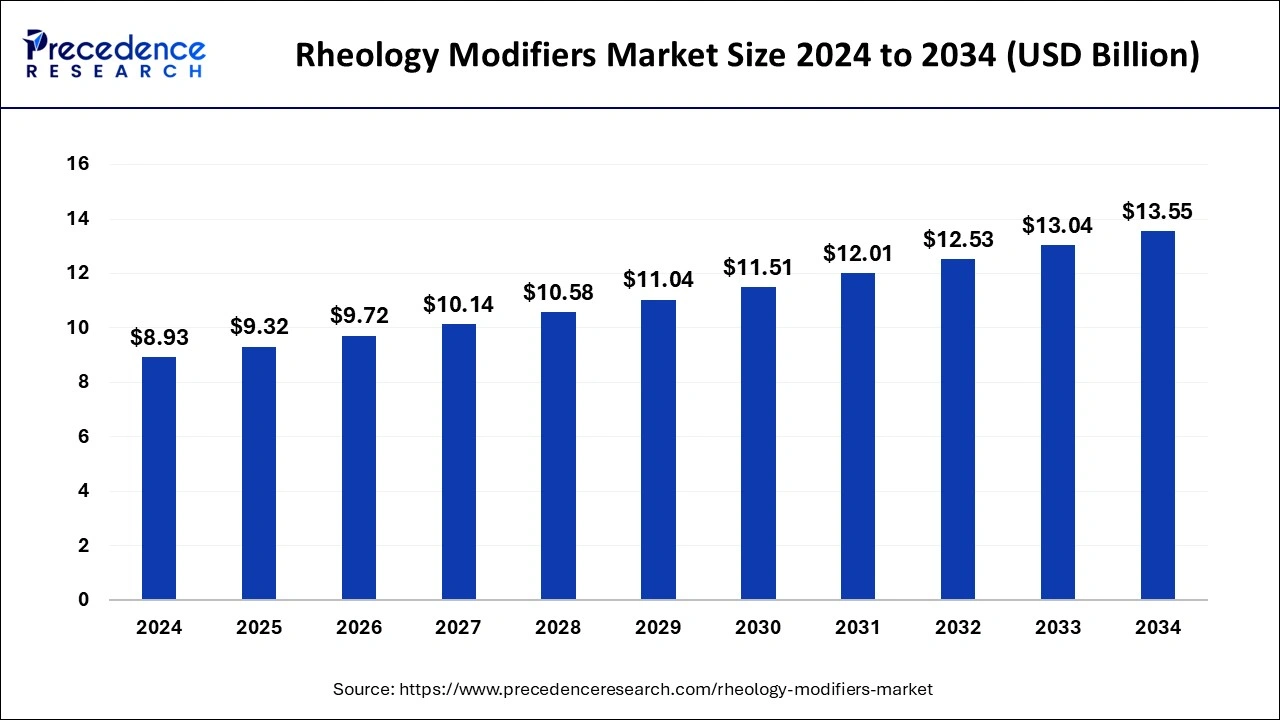
Rheology Modifiers Market Key Takeaways
- By type, the organic segment accounted for the major market share of 65% in 2024.
- By type, the inorganic segment is expected to grow at the fastest CAGR during the forecast period.
- By application, the paints and coatings segment contributed the biggest market share of 38% in 2024.
- By distribution channel, the indirect segment has held the biggest market share of 60% in 2024.
- By distribution channel, the indirect segment is projected to grow at a significant CAGR during the forecast period.
The Impact of AI on the Rheology Modifiers Market
Integration of AI in rheological modifiers is crucial to gain precise knowledge of the rheological characteristics of fresh concrete to ensure its viscosity at optimum level. AI models like gaussian process regression, multilayer perceptron neural network and radial basis function neural network are primary models used for precise viscosity measurement. According to the statistical data derived from these models, all models present satisfactory outcome for rheological factors, highlighting AI's role in the rheological modifiers market.
Asia Pacific Rheology Modifiers Market Size and Growth 2025 to 2034
The Asia Pacific rheological modifiers market size was evaluated at USD 3.21 billion in 2024 and is projected to be worth around USD 4.94 billion by 2034, growing at a CAGR of 4.40% from 2025 to 2034.
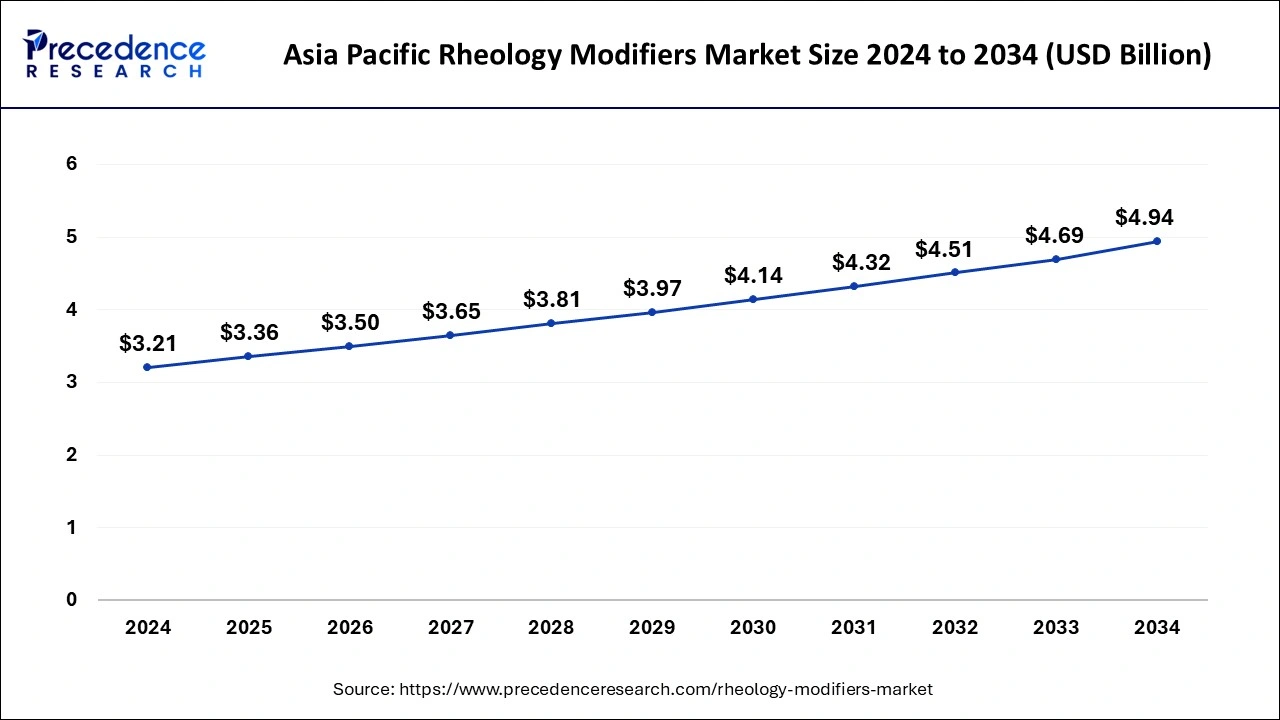
Based on region, the Asia Pacific is the largest market for rheology modifiers, followed by North America and Europe. The massive industrial growth in the Asia Pacific has been fueling the growth of the rheology modifiers market over the past few years, which is expected to continue during the next five years as well. Over the past ten years, both domestic and international investments have steadily increased in important industries like mining, manufacturing, energy, and construction.
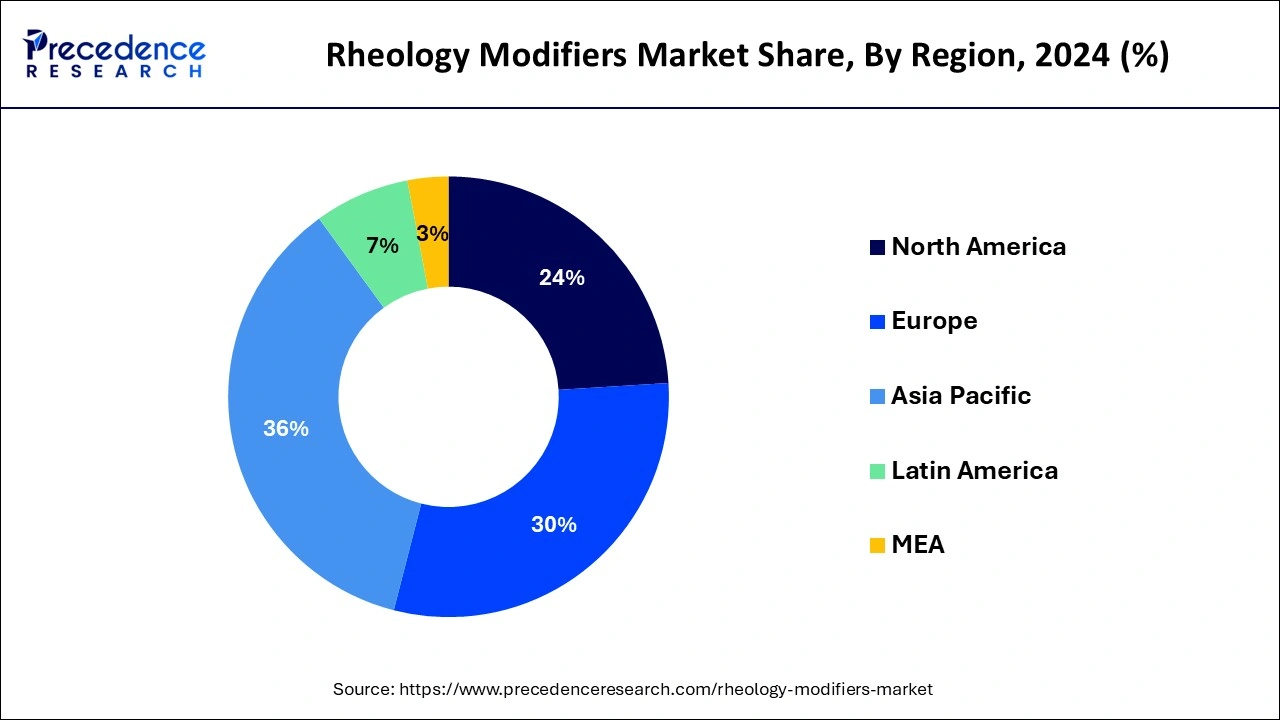
According to the IMF, the GDP growth rate of China was 8 % in 2021, which is expected to result in the growth of the industrial sector and the demand for rheology modifiers in the country. India's GDP has grown at a moderate rate over the previous ten years. The nation has drawn significant investment in major financial sectors like construction, cement, personal care, and energy. The outlook for India's economy has been excellent. The Indian government is concentrating on the manufacturing sector by liberalizing rules and offering additional incentives, such as cheap land and expedited permissions from all relevant authorities. As a result, the economy in its entirety is growing rapidly. During the projection period, this is anticipated to fuel the region's need for rheology modifiers.
Market Overview
Rheology is defined as the direct relationship between the strain and stress of the substance. It helps to know the mechanical behavior of the substances with the surfaces. Also, Rheology refers to the study of the flow of materials, and one of the most common rheology measurements is viscosity - or the measurement of the resistance of a fluid to flow. For numerous applications in the majority of sectors, including food and beverage, paints, inks, coatings, oil, cosmetics, and pharmaceuticals, viscosity is a crucial rheological parameter.
Rheology modifiers are typical additives used in almost every industry to manage non-Newtonian behaviors like shear thinning or shear thickening as well as to change the overall viscosity magnitude. These essential ingredients can aid to control shelf stability, ease of application, texture, and processability in addition to helping to obtain the proper viscosity. Viscosity measurements can also be used to investigate the effects of protein solution formulation changes. By introducing and measuring changes in rheological properties when the formulation is changed, intermolecular interactions can be investigated. There are several different rheology modifiers available. The common rheology modifiers used in multiple industries are Arginine, K-carrageenan, Xanthan Gum, Laponite, and others.
The primary types of rheology modifiers are Alkali Swellable Emulsions (ASE), Hydrophobically modified Alkali Swellable Emulsion (HASE), Hydrophobically modified Ethoxylated Urethane Resin (HEUR), Hydroxyethyl Cellulose (HEC), and Nonionic Synthetic Associative Thickener (NSAT). Common applications of rheology modifiers include: stabilizing lubricant viscosity in a variety of temperatures, enhancing curing and preventing sedimentation in inks and paints, improving permeability and sweep efficiency of suspension drilling fluids, and altering the characteristics of food and pharmaceutical products.
In order to enhance solvent-borne, water-borne, UV-cured, and high-solid systems, viscosity modifiers including hectorite, fumed silica, and polyether polyol associative thickeners are commonly implemented in adhesives and sealants.
Rheology Modifiers Market Growth Factors
- Increasing application of rheology modifiers in diverse sectors like food and beverages, paints, cosmetics, oil and coatings.
- Growing use of advanced rheology modifiers like K-carrageenan, arginine to manage viscosity of fluid is the primary growth factor for the market.
- Major leaders of the rheology modifiers market are investing heavily in R&D activities to expand their portfolio across the globe.
- Increasing strategic initiatives like contractual agreements, novel product launches to gain consumer base, collaboration among leading players are the driving factor for the market.
Market Scope
| Report Coverage | Details |
| Market Size in 2025 | USD 9.32 Billion |
| Market Size by 2034 | USD 13.55 Billion |
| Growth Rate from 2025 to 2034 | CAGR of 4.25% |
| Base Year | 2024 |
| Forecast Period | 2025 to 2034 |
| Largest Market | Asia Pacific |
| Segments Covered | Type, Application, Distribution Channel, and Regions |
| Regions Covered | North America, Europe, Asia-Pacific, Latin America, Middle East & Africa |
Market Dynamics
Increasing demand for coatings & paint applications in different sectors such as automotive & construction, oil & gas is likely to flourish the requirement for rheology modifiers market in the coming years. In addition to this, employment of rheology modifiers is elevating owing to the increasing requirement for personal care products all over the world during the upcoming few years. On the other hand, the technological alteration to digital media from conventional paper printing is expected to slow down the requirement for the rheology modifiers market. In addition to this, the fluctuating costs of gas & oil are also likely to have a negative effect on the development of the rheology modifiers market in the upcoming years.
Nonetheless, emerging different end industries in the Asia Pacific are likely to increase new opportunities for major companies in the rheology modifiers market in the coming years. Moreover, different mergers and acquisitions in the rheology modifiers market are set to propel the market growth. In addition, rising disposable income among individuals and subsequent demand for sophisticated and high-quality houses and infrastructure, along with rising production of automotive vehicles is expected to further boost demand for paints and coatings, in turn, contribute to revenue growth of the rheology modifiers market.
The growing demands of rheology modifiers in food & beverages, pharmaceuticals, cosmetics & personal care, and other industries to maintain the thickness of products as well as the shelf life of that product and preserve them for a longer period in their required state is driving the market growth.
Additionally, developing infrastructures in many nations demand paint & coatings for the protection of that infrastructure from environmental conditions which is boosting the rheology modifiers market. Also, the increasing media attraction in the new generation to look attractive is growing the sales of many beauty products which is further rising the demand for rheology modifiers in cosmetics & personal care applications.
The raw elements needed to synthesize viscosity modifiers are manufactured using crude oil, which is a crucial component. The cost of common chemicals and the raw materials needed to make products are some of the things that are most strongly influenced by fluctuating crude oil prices. One of the key growth inhibitors for the market for rheology modifiers is the volatility of crude oil prices.
Furthermore, the availability of raw materials, processing diffractions, worker charges, and diverse costs of modifiers in different industries like adhesives & sealants, pharmaceuticals, paint and coatings, oil & gas, construction, inks, agriculture, textile, mining, water treatment, and others are restraining the market development.
Type Insights
Based on type, the segment is categorized into organic and inorganic. The organic segment accounted for the largest share of the market during the analysis period. It is also expected to be the fastest-growing segment during the study period. Organic rheology modifiers are more diverse in terms of chemistry and availability than inorganic rheology modifiers and are mainly based on natural raw materials. They are further divided into two main categories natural and synthetic. The primary drivers of this market are the superior performance of organic rheology modifiers in a variety of applications and their environmental friendliness.
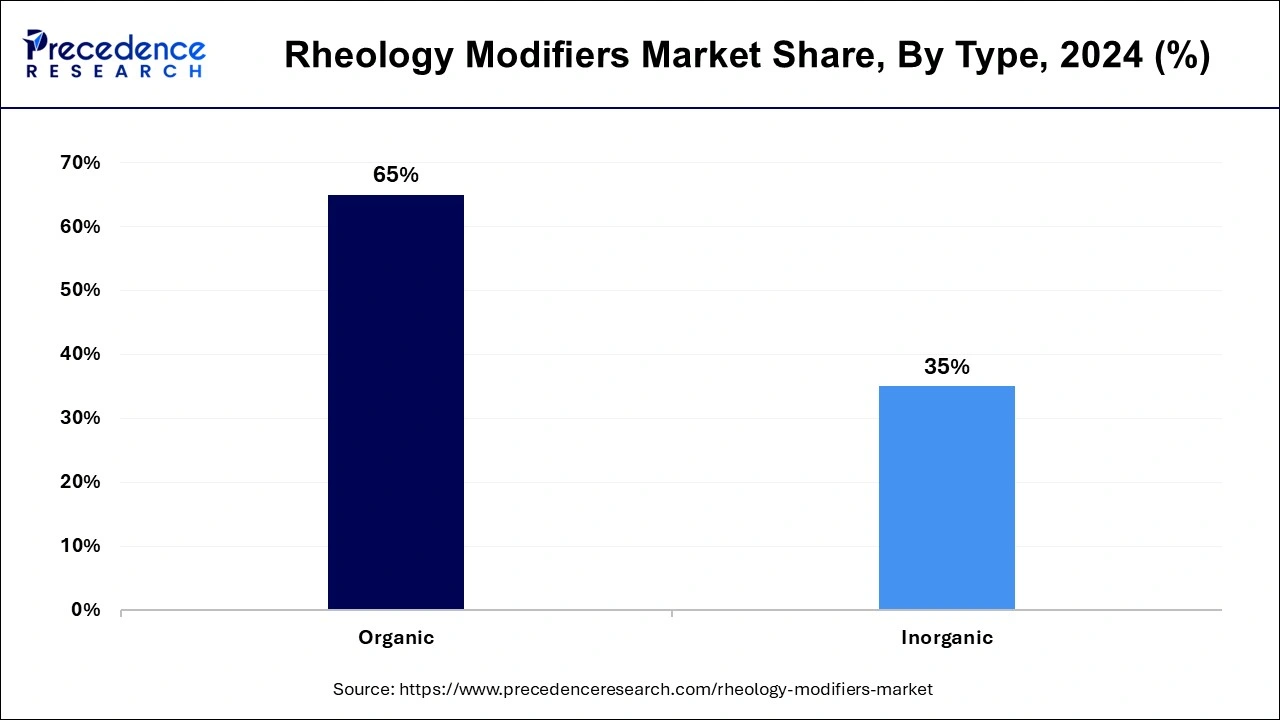
Moreover, inorganic thickeners are frequently utilized in the formulation of cosmetic and personal care products. They are widely used in the pharmaceutical and paints and coatings industries when in the precipitated form. Demand for inorganic rheology modifiers is expected to increase significantly.
Application Insights
Based on application, the segment is divided into paints & coatings, cosmetics & personal care, adhesives & sealants, pharmaceuticals, home care, oil & gas, construction, inks, and others. The paints & coatings application accounted for the largest share in 2021. In construction, automotive, aerospace, marine, wood, general industrial, and other industries, paints and coatings have a wide range of applications. Owing to population growth and urbanization, high growth is expected in paints & coatings, adhesives &inks, cosmetics & personal care, and home care applications during the forecast period, which, in turn, is expected to fuel the rheology modifiers market. China, India, and the US are expected to drive the demand for rheology modifiers in the future market.
Additionally, the growth of digital media and the ensuing decline in ink usage is expected to limit industry growth to some extent. However, a promising prognosis for application in the fields of cosmetics, personal care, building, medicine, paints & coatings, and sealants & adhesives will promote the growth of the market in the forthcoming years.
Distribution Channel Insights
Based on the distribution channel the segment is characterized by direct and indirect distribution. Indirect distribution dominated the market in 2021, owing to the increasing sales and demands of exporters, importers, wholesalers, and retailers for the products.
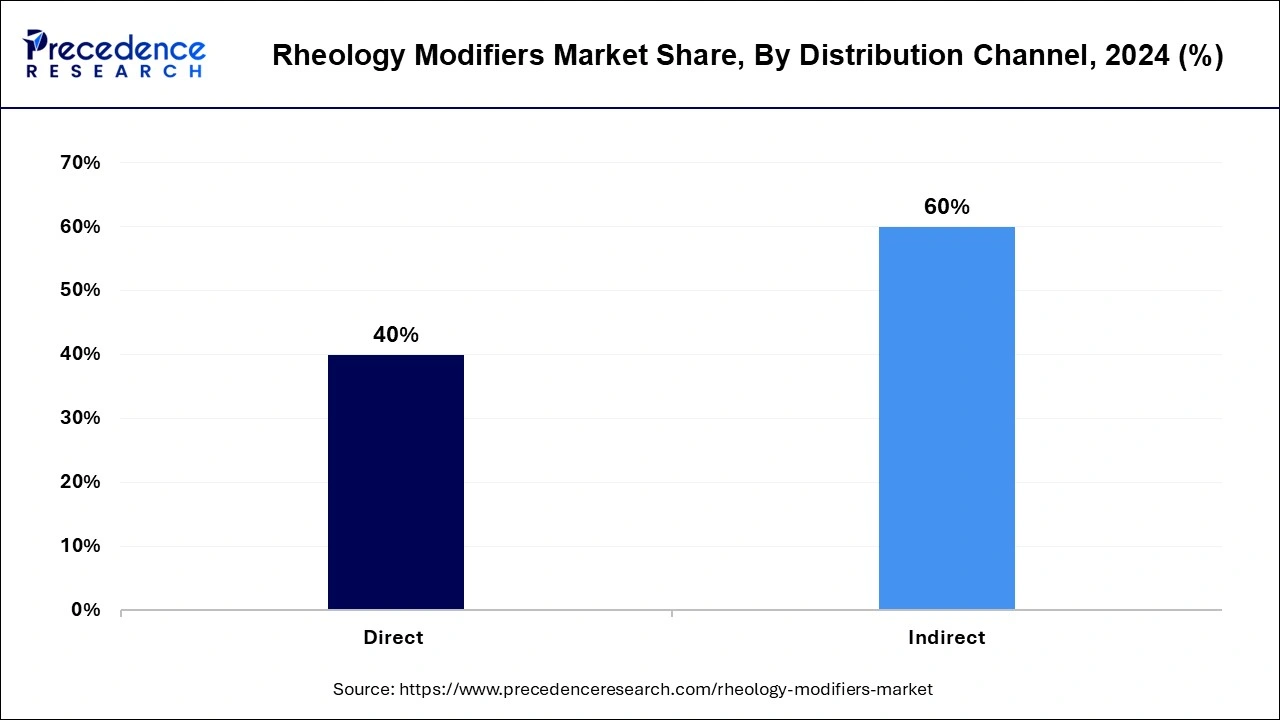
Also, the 3PL is helping to boost the market during the analysis period. Furthermore, the direct distribution is increasing the demand in the rheology modifiers market due to the direct supply of the product to the consumers which is lowering the prices of the products and making more demands on them.
Recent Developments
- In February 2024, leading player AkzoNobel N.V. expanded itself for its coatings manufacturing facility in Italy with spent of USD 22.7 million, aiming to improve company's capacity to offer best services for consumers of eastern Europe by launch of four new manufacturing lines. Como's improved capacity and the use of recycled energy in its new lines have led to a reduction in its carbon footprint by 50%. This lines up with the company's ambition to reach the goal in 2030. The facility supplies inventory with home appliances, automotive, architecture, agriculture, furniture, and heavy machinery.
- In February 2024, Arkema, a French leader in paints and solvents, released two new bio-based waterborne resins with Synaqua providing up to 97% renewable materials while maintaining the strength of alkyd-based coatings as well as the unique benefits of water-based formulations. Crayvallac is an up to 100% recyclable rheology high-performance modifier that derives from castor oil and a polyamide base.
Rheology Modifiers Market Companies
- BASF SE
- Dow
- The Lubrizol Corporation
- Clariant
- Arkema
- Croda International Plc
- Ashland
- Akzo Nobel N.V.
- ELEMENTIS PLC
- RheoSense, Inc.
Segments Covered in the Report
By Type
- Organic
- Synthetic
- Natural
- Inorganic
- Clay
- Fumed Silica
By Application
- Paints & Coatings
- Cosmetics & Personal Care
- Adhesives & Sealants
- Pharmaceuticals
- Home Care
- Oil & Gas
- Construction
- Inks
- Others
- Agriculture
- Textile
- Mining
- Water Treatment
By Distribution Channel
- Direct
- Indirect
By Geography
- North America
- Europe
- Asia-Pacific
- Latin America
- Middle East & Africa (MEA)
For inquiries regarding discounts, bulk purchases, or customization requests, please contact us at sales@precedenceresearch.com
Frequently Asked Questions
Ask For Sample
No cookie-cutter, only authentic analysis – take the 1st step to become a Precedence Research client